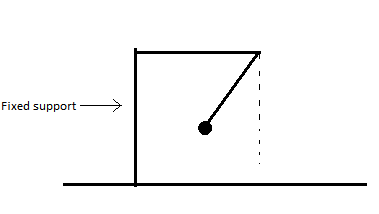The pendulum effect
 An experiment based on pendulum is being done on ground, as shown in the above diagram
An experiment based on pendulum is being done on ground, as shown in the above diagram
A Pendulum with a bob of mass and negligible size is attached to a fixed support which is fixed to the ground and is released at an angle with the vertical. When the bob reaches the lower most point a sophisticated machine measures it's velocity as

Now the same experiment is being done with the fixed support being fixed on a cart which is itself is placed on a very smooth ground(cart is free to move and currently at rest) and the pendulum is attached to the fixed support exactly as in the first experiment.
Also this time the measuring machine is placed on the cart itself(measuring machine has negligible mass). Again pendulum is released from the same angle with the vertical.
This time that machine measures the velocity of the bob when it was at it's lowest position as . Find the mass of the cart in
Details and Assumptions
1)Assume the mass of the fixed support to be neglible.
The answer is 49.75.
This section requires Javascript.
You are seeing this because something didn't load right. We suggest you, (a) try
refreshing the page, (b) enabling javascript if it is disabled on your browser and,
finally, (c)
loading the
non-javascript version of this page
. We're sorry about the hassle.
(Subscript p means pendulum and subscript c means cart)
When the pendulum is on the cart, the cart will always have the opposite horizontal momentum as the pendulum. When the pendulum is at it's lowest point, all of it's momentum is horizontal:
m p ∣ v p ∣ = m c ∣ v c ∣
When the pendulum is released without the cart, it has 0.5 joules of energy. Since it is released from the same angle, the energy of the system will also be 0.5 joules when it is placed on the cart:
2 1 ( m p v p 2 + m c v c 2 ) = 2 1
We can relate the speed of the pendulum relative to the cart (the measured speed) to the individual speeds of the cart and pendulum:
∣ v p ∣ + ∣ v c ∣ = v m e a s u r e d = 1 . 0 1 m/s
These three equations hold the answer. The problem is now just an exercise in algebra.